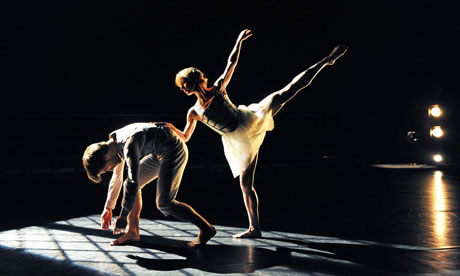Richard Alston Dance Company has grown into the UK's most avidly followed contemporary dance company. At least that's the claim made in the programme for the company's autumn season, which kicked off at the Place last week. And although I didn't recognise any avidity monitors in the crowd at the bar, it may even be true. Certainly the Alston faithful are a cheerfully vocal bunch, secure in the knowledge that their hero is carrying the torch for a fine, unsullied tradition.
But some of us, on occasion, struggle. Alston's choreographic roots are in the austere soil of mid-20th-century American abstraction. As an alumnus of the London Contemporary Dance School, he was one of the first generation of British dance-makers to be raised in the Martha Graham technique, and further studies included a two-year stint at Merce Cunningham's studio in New York. The work that he has made since then is rigorous in its minimalism, even as it is scrupulous in its musicality. His dancers are bodies in space, facially expressionless, impelled by the music and the moment. The winds of irony may howl outside, but in the airy cathedral of modernism all is calm.
As one of the temperamentally impious, I find Alston's work easier to admire than to love. At its heart is a puritanism with which I can engage intellectually, but not emotionally. There is a faultline in British dance today between those who see dance as theatre, and those who see it as art event. The thrust of the past few decades has been towards a theorisation of dance, and in consequence a favouring of the art-event tendency. And this is how I've finally resolved my Alston issues. I tell myself I'm not in a theatre but in an art gallery with a stage. By dispensing with any expectations of the theatrical, the work swims into its proper focus.
Wednesday's first exhibit was Shimmer, a full-company piece to piano works by Ravel. A series of duets culminating in a long solo, with overlapping ensemble passages, its taut structure contrasts with the evanescence of the music. A particularly striking feature of the choreography is its yearning towards classicism. There's a repeated statement of the balletic retiré position, with thighs turned out from hips and pointed feet raised to the knee. With jewelled, cobwebby costumes by Julien Macdonald, and an ineluctable sense of the stars in their courses, this is Alston at his most high church. Low-church Alston is represented by Darknesse Visible, a plangent, floor-bound solo for Pierre Tappon (the title, appropriately, comes from Milton's Paradise Lost).
Isthmus is Alston's response to a composition by the Japanese composer Jo Kondo. At once cool and intricate, it sees five dancers intersecting at speed to form a weightless geometric tracery. The piece's lightness of being contrasts with the punchy weight of Martin Lawrance's Madcap, set to a complex score by the American Julia Wolfe. Lawrance has always created notably interesting work for male dancers, and here we see the excellent Nathan Goodman as a spiderish outsider, coiling and uncoiling with steely intent to Wolfe's stuttering rhythms. Madcap also showcases Liam Riddick, a young dancer of mercurial speed and poise who remains unfazed by the most extreme demands, riding the music's choppy currents with a faint, serene smile.
Placing Alston's work in an imaginary gallery sets it, for me, in its proper perspective. But even as I admire its precision and craft, I find myself wondering if any artwork can exist quite so independently of the world around it as Alston's seems to. Shimmer, with its intimation of the elevated aesthetic state, is a telling title. How much is lost when you quite so resolutely eliminate bathos, chaos, humour and the rough edge? For me there is a denial of history in the fact that modernist abstract dance remains to such a large extent the establishment form in this country, and I suspect that the plinth on which it stands is going to have to get higher and higher as the postmodern tide rises about it. Real life, in all its disorder, has a way of asserting itself, and when it does, contemporary dance will depart the art space and set about reclaiming the theatre.









